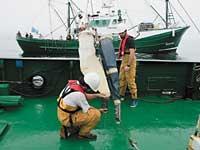Is there enough anchovy?
Last June, AZTI ended the campaign to know the situation of anchovy in the Bay of Biscay and announced the provisional results.

In view of the results, it can be said that this year the number of anchovy eggs in the sea is lower, so it is estimated that biomass is also lower on average. Another significant fact is that this year's campaign has captured 7,000 tons of anchovy, a figure that, despite being higher than 2003 (3,000 tons), is much lower than the average in recent years (13,000 tons).
However, it seems that the presence of eggs in the sea depends not only on anchovy biomass, but also on low fecundity (amount of eggs laid in anchovy). This may be due, among other things, to the low temperatures of marine waters.
Now, these first data should be confirmed by researchers in the studies conducted with adult anchovies, which will allow obtaining the actual biomass data of anchovy.





